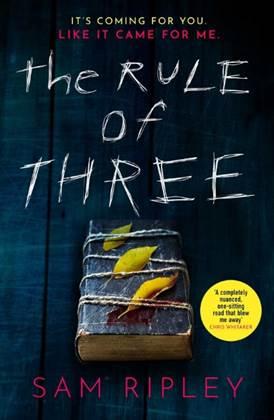
When she comes to believe that seemingly unrelated tragedies share a sinister connection, a young woman must solve the mysterious urban myth known as the Rule of Three or be the next one to die. But when she can’t be sure what is happening is even real, how can she solve something she doesn’t even understand?
Don’t forget The Rule of Three/It’s coming for you/Like it came for me.
Many, many years ago when I was on my way home from school, one of my friends warned me never to walk over a row of three drain covers. I was just about to do so without a second thought as I don’t think I had ever paid any attention to drain covers before but he warned me in no uncertain terms that it was bad luck. I had never heard of such a thing, although I knew that a black cat crossing your path was supposed to be an ill omen. For reasons I can’t remember I took this warning about the three drains seriously. Perhaps I was more superstitious back then or maybe I was simply an impressionable youth. The end result was the same: I then went out of my way to avoid walking over three drains and I warned everyone who would listen not to do the same. Which almost ended in tragedy when I would take this obsession to its extreme.
Walking with my brother one day I saw him about to walk over a row of three drain covers and intervened, shoving him clear to prevent him strolling into imminent danger. He was a little older and a lot more sensible and grounded so had summarily dismissed my prior warning. So, if he wasn’t going to save himself I was going to do it for him. Taking him by surprise, my shove sent him stumbling off the pavement and into the road where he was very nearly struck by a passing car. For obvious reasons, he was not best pleased with my intervention.
Now I’m a lot older and hopefully a good deal wise I don’t think of myself as especially superstitious but I’ll sometimes touch wood and occasionally a row of three drain covers will draw my eye. I’m not sure when I heard that bad things happen in threes but it’s one of those ubiquitous superstitious that seem to have always been around. At some point I was under the impression it began in the First World War when soldiers learned never to light their cigarettes in threes at night since by the time the third man’s cigarette was lit an enemy sniper would have had time to draw a bead on him. During the research for The Rule of Three, however, I found out this was attributed to the Boer War. I also learned that apophenia is the tendency to make connections between unrelated events. Just because something seems like a pattern doesn’t mean it’s anything more than coincidence.
But if that pattern suggests you are going to die too, can you bet your life it’s only apophenia? That’s one of the questions facing the protagonist in the Rule of Three, who is forced to work on the assumption she’s doomed unless she can somehow change her own fate. Which naturally leads to the biggest question of them all: why is this happening at all?
The Rule of Three was a lot of fun to write both in the story and the characters but also in the telling. The book is written as a journal, or as a survival guide as one of the characters refers to it, written for the benefit of the reader who the narrator is trying to help. By telling her own story as it happened, how it happened, she hopes to pass on what she learned so the reader can save themselves from the same fate.
But will she even survive herself?
‘The Rule of Three is a completely original, nuanced, one-sitting read that blew me away. Whip-smart dialogue, characters that haunt your dreams and a plot you might just die for. I loved it’ - Chris Whitaker

22 June 2023 | Hardback | £14.99
Simon & Schuster